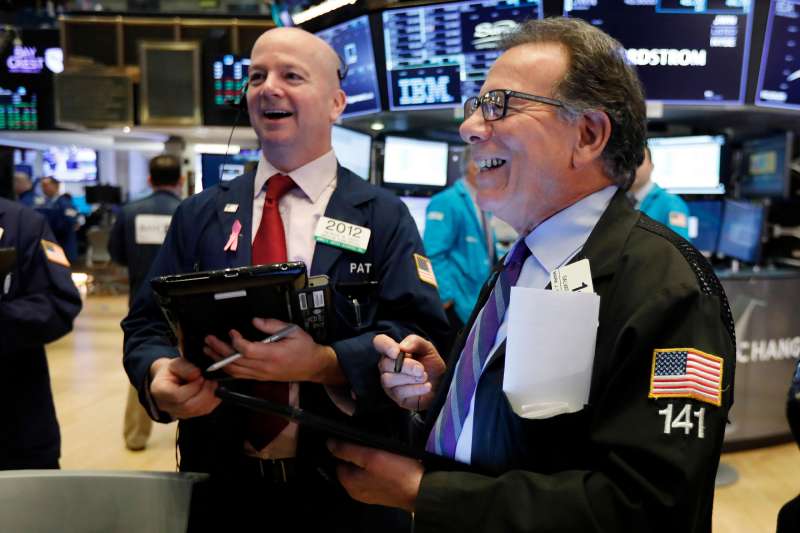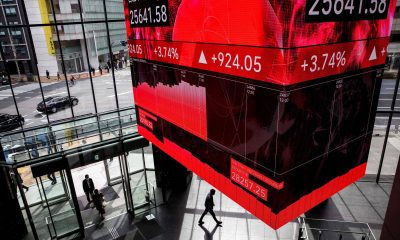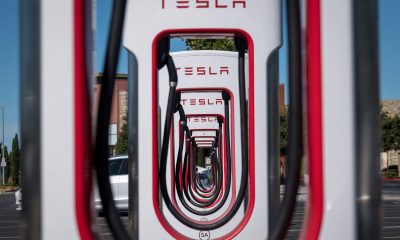Economy
Powell, U.K. inflation, Tesla’s investment – what’s moving markets

Fed chief Jerome Powell starts his congressional testimony later in the session, after data showed that U.K. inflation remained elevated in May. Tesla is looking towards India for investment, while FedEx disappoints with its earnings.
1. Powell starts congressional testimony
Federal Reserve chief Jerome Powell starts his two-day congressional testimony later Wednesday, addressing the House Financial Services Committee just a week after the U.S. central bank paused rate increases but signaled it could raise rates again this year.
The Fed projected that the benchmark rate could reach 5.6% by the end of the year, which would imply at least two increases of 25 basis points.
With this in mind, investors will be looking to see how strongly Powell stresses the need to resume rate hikes and whether they will restart as quickly as next month.
“The focus is on whether the July meeting is truly ‘live’ and if the Fed dot plot of two more hikes is a true base case depending on the data, or doom-mongering on inflation in an effort to ensure no premature easing in financial conditions,” said Tapas Strickland, head of market economics at NAB.
2. U.K. inflation remains elevated
U.K. inflation surprised on the upside earlier Wednesday, as headline CPI rose 8.7% in May, the same as the month before, and above the expected 8.4%.
Additionally, core inflation, which excludes food and energy, accelerated unexpectedly to 7.1% from 6.8%, heaping pressure on the Bank of England to ratchet up its interest rate hikes when it meets on Thursday.
The BOE is expected to raise rates by 25 basis points to 4.75%, though this inflation data increases the risk of a half-point increase as the central bank continues its quickest tightening cycle in 40 years.
Adding to the country’s woes, a separate report showed that U.K. government debt climbed above 100% of GDP for the first time since 1961 after the government borrowed a greater-than-forecast £20 billion (£1 = $1.2708) in May.
3. Futures flat; FedEx stock weakens
U.S. futures traded largely unchanged Wednesday, with investors awaiting testimony from Federal Reserve Chair Jerome Powell [see above] for some insights on what lies ahead for interest rates.
At 05:00 ET (09:00 GMT), the Dow futures contract had dropped just 3 points or less than 0.1%, S&P 500 futures traded flat, and Nasdaq 100 futures dropped 6 points or 0.1%.
The main indices closed lower Tuesday as investors took money off the table in the wake of last week’s strong gains after the Fed paused its prolonged rate-hiking cycle.
The broad-based S&P 500 last week hit its highest level since April 2022 and posted its fifth consecutive positive week.
In corporate news, quarterly earnings are due from the likes of home builder KB Home and recreational vehicle maker Winnebago Industries, while delivery giant FedEx stock fell premarket after ongoing “demand challenges” prompted its plans to ground 29 more aircraft in the fiscal year that started on June 1.
4. Tesla looks toward India
Elon Musk is turning his eyes once more towards India, the world’s most populous country, after the Tesla CEO met with Narendra Modi during the Indian Prime Minister’s visit to the U.S.
“I’m confident that Tesla will be in India and we’ll do so as soon as humanly possible,” Musk told reporters after the meeting. “We don’t want to jump the gun on an announcement, but I think it’s quite likely that there will be a significant investment.”
Tesla and India have had discussions about investment into Asia’s third-largest economy before, but they were shelved last year after the Indian government insisted Tesla make cars locally, while the EV manufacturer said it wanted to export to India first so that it could test demand.
5. Oil edges higher ahead of U.S. inventories
Crude prices edged higher Wednesday, bouncing after two straight losing sessions, ahead of the latest weekly U.S. inventory data.
By 05:00 ET, U.S. crude futures were 0.3% higher at $71.39 a barrel, while the Brent contract rose 0.2% to $76.03 per barrel.
U.S. oil inventory data from the American Petroleum Institute industry group will be released later on Wednesday, delayed by a day following Monday’s public holiday, and a drawdown is possible after last week’s hefty one million barrel build.
That said, the oil market is struggling to find support, even after Saudi Arabia decided to limit its supply, amid growing concerns over an economic recovery in China, the world’s largest crude importer, as well as tightening monetary policy through much of the west limiting economic activity.
“OPEC+ action from several weeks ago has done little to propel prices higher and demand concerns continue to put a cap on the market,” analysts at ING said, in a note.
Economy
Russian central bank says it needs months to make sure CPI falling before rate cuts -RBC


© Reuters. Russian Central Bank Governor Elvira Nabiullina attends a news conference in Moscow, Russia June 14, 2019. REUTERS/Shamil Zhumatov/File Photo
MOSCOW (Reuters) – Russia’s central bank will need two to three months to make sure that inflation is steadily declining before taking any decision on interest rate cuts, the bank’s governor Elvira Nabiullina told RBC media on Sunday.
The central bank raised its key interest rate by 100 basis points to 16% earlier in December, hiking for the fifth consecutive meeting in response to stubborn inflation, and suggested that its tightening cycle was nearly over.
Nabiullina said it was not yet clear when exactly the regulator would start cutting rates, however.
“We really need to make sure that inflation is steadily decreasing, that these are not one-off factors that can affect the rate of price growth in a particular month,” she said.
Nabiullina said the bank was taking into account a wide range of indicators but primarily those that “characterize the stability of inflation”.
“This will take two or three months or more – it depends on how much the wide range of indicators that characterize sustainable inflation declines,” she said.
The bank will next convene to set its benchmark rate on Feb. 16.
The governor also said the bank should have started monetary policy tightening earlier than in July, when it embarked on the rate-hiking cycle.
Economy
China identifies second set of projects in $140 billion spending plan


© Reuters. FILE PHOTO: Workers walk past an under-construction area with completed office towers in the background, in Shenzhen’s Qianhai new district, Guangdong province, China August 25, 2023. REUTERS/David Kirton/File Photo
SHANGHAI (Reuters) – China’s top planning body said on Saturday it had identified a second batch of public investment projects, including flood control and disaster relief programmes, under a bond issuance and investment plan announced in October to boost the economy.
With the latest tranche, China has now earmarked more than 800 billion yuan of its 1 trillion yuan ($140 billion) in additional government bond issuance in the fourth quarter, as it focuses on fiscal steps to shore up the flagging economy.
The National Development and Reform Commission (NDRC) said in a statement on Saturday it had identified 9,600 projects with planned investment of more than 560 billion yuan.
China’s economy, the world’s second largest, is struggling to regain its footing post-COVID-19 as policymakers grapple with tepid consumer demand, weak exports, falling foreign investment and a deepening real estate crisis.
The 1 trillion yuan in additional bond issuance will widen China’s 2023 budget deficit ratio to around 3.8 percent from 3 percent, the state-run Xinhua news agency has said.
“Construction of the projects will improve China’s flood control system, emergency response mechanism and disaster relief capabilities, and better protect people’s lives and property, so it is very significant,” the NDRC said.
The agency said it will coordinate with other government bodies to make sure that funds are allocated speedily for investment and that high standards of quality are maintained in project construction.
($1 = 7.1315 renminbi)
Economy
Russian central bank says it needs months to make sure CPI falling before rate cuts -RBC


© Reuters. Russian Central Bank Governor Elvira Nabiullina attends a news conference in Moscow, Russia June 14, 2019. REUTERS/Shamil Zhumatov/File Photo
MOSCOW (Reuters) – Russia’s central bank will need two to three months to make sure that inflation is steadily declining before taking any decision on interest rate cuts, the bank’s governor Elvira Nabiullina told RBC media on Sunday.
The central bank raised its key interest rate by 100 basis points to 16% earlier in December, hiking for the fifth consecutive meeting in response to stubborn inflation, and suggested that its tightening cycle was nearly over.
Nabiullina said it was not yet clear when exactly the regulator would start cutting rates, however.
“We really need to make sure that inflation is steadily decreasing, that these are not one-off factors that can affect the rate of price growth in a particular month,” she said.
Nabiullina said the bank was taking into account a wide range of indicators but primarily those that “characterize the stability of inflation”.
“This will take two or three months or more – it depends on how much the wide range of indicators that characterize sustainable inflation declines,” she said.
The bank will next convene to set its benchmark rate on Feb. 16.
The governor also said the bank should have started monetary policy tightening earlier than in July, when it embarked on the rate-hiking cycle.

 Forex2 years ago
Forex2 years agoForex Today: the dollar is gaining strength amid gloomy sentiment at the start of the Fed’s week

 Forex2 years ago
Forex2 years agoHow is the Australian dollar doing today?

 Forex1 year ago
Forex1 year agoUnbiased review of Pocket Option broker

 Forex2 years ago
Forex2 years agoDollar to pound sterling exchange rate today: Pound plummeted to its lowest since 1985

 Cryptocurrency2 years ago
Cryptocurrency2 years agoWhat happened in the crypto market – current events today

 World2 years ago
World2 years agoWhy are modern video games an art form?

 Stock Markets2 years ago
Stock Markets2 years agoMorgan Stanley: bear market rally to continue

 Economy2 years ago
Economy2 years agoCrude oil tankers double in price due to EU anti-Russian sanctions

































